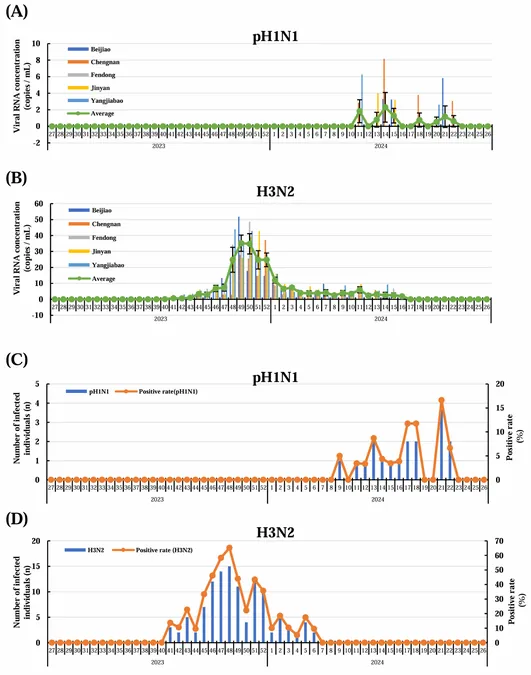
Unmasking the Flu: Surprising Insights from Wastewater and Health Samples in Taiyuan, China!
2024-11-12
Author: Yu
Introduction
In the midst of the potentially devastating impacts of influenza viruses, a groundbreaking epidemiologic surveillance study conducted in Taiyuan, China, has unveiled critical insights regarding the prevalence and genetic mutations of Influenza A viruses (IAVs) during the 2023-2024 season. Each year, seasonal influenza accounts for approximately a billion cases worldwide and leads to an estimated 3-5 million cases of severe illness. The urgency of this study cannot be overstated, especially given that IAVs have been known to trigger pandemics, as seen historically.
Influenza A Viruses and Their Challenges
Influenza A viruses are notorious for their ability to mutate due to their segmented RNA structure, allowing them to undergo rapid antigenic changes. This year's study particularly focused on two well-known strains: H1N1, which has been circulating since 2009, and H3N2, which has been around since 1968. Both strains are capable of afflicting individuals of all ages, with higher risks for young children, the elderly, pregnant women, and immunocompromised individuals. Vaccination has traditionally been a frontline defense against these viruses, yet the evolving nature of IAVs poses significant challenges in ongoing vaccine efficacy.
Surveillance Methods
The surveillance system in China has traditionally relied on passive reporting from hospitals—an approach with notable limitations. Most patients exhibiting mild symptoms do not seek clinical care, leaving many cases undetected. In contrast, monitoring wastewater provides new avenues for tracking public health threats. The wastewater method allows researchers to detect viral RNA from infected individuals through biological waste—offering a broader perspective on community infection rates not captured via traditional clinical testing.
Key Findings from Wastewater Analysis
This study collected wastewater samples from five treatment plants serving over two million residents in Taiyuan. Results indicated that while H3N2 had a more sustained presence, peaking in late 2023, the H1N1 strain appeared sporadically and was less concentrated in sampled wastewater. These findings suggest that the H3N2 strain may pose a greater immediate threat to the population.
Health Sample Analysis
In parallel, respiratory specimens were gathered from outpatients displaying influenza-like symptoms in a local hospital. The results were alarming: 11.2% of tested patients were found to be infected, with a striking dominance of H3N2 at 119 cases compared to just 16 cases of H1N1. Such statistics illustrate the urgent need for enhanced strategies to mitigate the impact of these viruses within the community.
Genetic Sequencing Insights
Advanced genetic sequencing was also employed to analyze the viral strains, revealing that many of the circulating viruses had mutations potentially impacting vaccine effectiveness. Of particular concern was a mutation in H3N2 that affected a glycosylation site, which may alter how the virus interacts with the human immune system, prompting a reconsideration of current vaccination strategies. Notably, no evidence of mutations conferring resistance to the antiviral drugs currently in use was found—but vigilance is required as the viruses continue to evolve.
Conclusion
Overall, this study underscores the importance of combining wastewater analysis with traditional health surveillance methods. Not only does it provide a more robust understanding of viral spread, but it also informs healthcare responses and public health policies. As the 2023-2024 influenza season unfolds, stakeholders must adapt based on latest findings to effectively address the ongoing threats posed by these ever-evolving viruses.
In conclusion, the findings from Taiyuan serve as a reminder of the unpredictable nature of influenza viruses and the constant need for comprehensive surveillance. Given the international travel and interconnectedness of our world, the emergence of new mutations could have repercussions far beyond China’s borders. Continuous monitoring and adaptation in response to these evolutionary changes remain crucial in protecting public health, and ensuring the effectiveness of vaccines and treatment strategies against influenza.



 Brasil (PT)
Brasil (PT)
 Canada (EN)
Canada (EN)
 Chile (ES)
Chile (ES)
 España (ES)
España (ES)
 France (FR)
France (FR)
 Hong Kong (EN)
Hong Kong (EN)
 Italia (IT)
Italia (IT)
 日本 (JA)
日本 (JA)
 Magyarország (HU)
Magyarország (HU)
 Norge (NO)
Norge (NO)
 Polska (PL)
Polska (PL)
 Schweiz (DE)
Schweiz (DE)
 Singapore (EN)
Singapore (EN)
 Sverige (SV)
Sverige (SV)
 Suomi (FI)
Suomi (FI)
 Türkiye (TR)
Türkiye (TR)